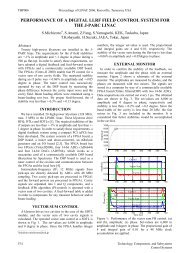Design and Development of a Diagnostics Client for a Beam Loss ...
Design and Development of a Diagnostics Client for a Beam Loss ...
Design and Development of a Diagnostics Client for a Beam Loss ...
You also want an ePaper? Increase the reach of your titles
YUMPU automatically turns print PDFs into web optimized ePapers that Google loves.
<strong>Design</strong> <strong>and</strong> <strong>Development</strong> <strong>of</strong> a <strong>Diagnostics</strong> <strong>Client</strong> <strong>for</strong> a <strong>Beam</strong> <strong>Loss</strong> Measurement System at CERN<br />
Name Status Prefix Interface Number Tag Number<br />
Payload<br />
Power Header x8002 x00 x00<br />
Power Payload x8002 x003f<br />
BLEDP FW Header x8002 x01 x00<br />
BLEDP FW Payload [31...16] x8002 x4e49<br />
BLEDP FW Payload [15...0] x8002 x4f53<br />
Chip ID Header x8002 x02 x00<br />
Chip ID Payload [63...48] x8002 xf700<br />
Chip ID Payload [47...32] x8002 x000e<br />
Chip ID Payload [31...16] x8002 x323c<br />
Chip ID Payload [15...00] x8002 x4801<br />
Table 2: Portion <strong>of</strong> Status Buffer Example<br />
We know from the memory map that the BLEDP FW record has a header with hex value<br />
0x0100 <strong>and</strong> a payload size <strong>of</strong> 32 bits. Firstly, we track the third integer point in the buffer<br />
<strong>and</strong> we notice that the bottom 16 bits match the BLEDP FW header. Following this ob-<br />
servation, we know that the next two points in the buffer contain the 32-bit payload <strong>of</strong> this<br />
element. It is shared between the bottom 16-bits <strong>of</strong> them. The same principles apply <strong>for</strong><br />
all the status elements.<br />
There is a specific class in the client side, which is designed <strong>and</strong> developed with the<br />
purpose <strong>of</strong> decoding the status buffers <strong>and</strong> getting the payload using several bitwise op-<br />
erations, in order to update the corresponding panel <strong>of</strong> the graphical user interface.<br />
4.3.4 <strong>Development</strong> Phases <strong>of</strong> the Communication Protocol<br />
The communication protocol between the embedded server <strong>and</strong> the diagnostics client<br />
was designed <strong>and</strong> developed in three different stages. These stages depend on whether<br />
single or multi-channel transmission is chosen <strong>and</strong> on the two acquisition methods (see<br />
chapter 3.2.2.1). The order <strong>of</strong> the development is the following:<br />
• Processed Data Transmission From One Channel.<br />
This mode is using the TCP/IP protocol <strong>for</strong> transmission <strong>of</strong> both the acquisition <strong>and</strong><br />
the status data. As already mentioned (see chapter 4.3.2), the <strong>for</strong>eseen data rate<br />
<strong>for</strong> this mode is around 16 Mbit/s. The BLEDP processed packet is produced every<br />
2 μs. There<strong>for</strong>e, a TCP packet with its agreed payload <strong>of</strong> 1400 bytes will contain<br />
350 BLEDP acquisition frames <strong>and</strong> will be filled within 700 μs.<br />
• Processed Data Transmission From All 8 Channels.<br />
This mode is using the UDP/IP protocol <strong>for</strong> the transmission <strong>of</strong> the acquisition data<br />
<strong>and</strong> the TCP/IP protocol <strong>for</strong> the transmission <strong>of</strong> the status data. The <strong>for</strong>eseen data<br />
rate <strong>of</strong> the acquisition data is 128 Mbit/s. Each channel produces one packet every 2<br />
Emmanouil I. Angelogiannopoulos 29















